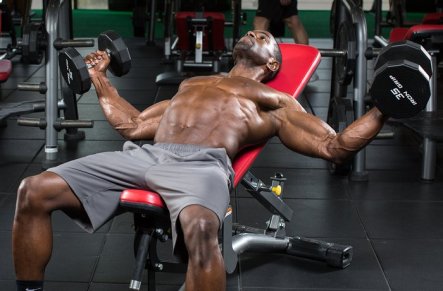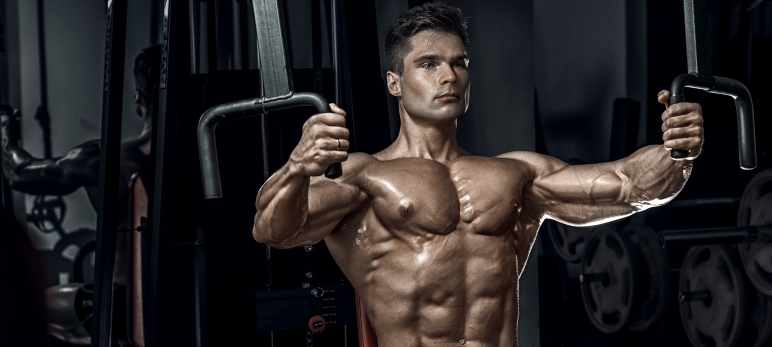Six basic principles of pumping infants, which will take you to a new level of mass
Breast training, in principle, it’s a simple matter. After all, we are talking about simple exercises like pressure and dilution. Nevertheless, the owners of a powerful and drawn chest can be counted on the fingers. What is the reason? Yes, the fact that the pectorals are big muscles, well, the training of such muscles is not given in small blood. The main rule is the peak intensity of training, superconcentration, huge weights and rivers of sweat. And, at every workout! And now look around. Someone persistently “dolbit” light crossover, someone Generic Viagra cheerfully waved nickel-plated dumbbells in a prone position. Well, where is the company of stubborn fans, crazy about heavy pressures? One presses – on the edge, so that the bones crack! Three more insure. Then the second, the third … In other words, where is the real work? That’s the answer!
Before you, precise guidelines about the “right” training of nursing. Remember, extremism is your main slogan. Hence the priority of basic exercises, minimum repetitions, a large rest interval for the complete restoration of muscles and nerves …
Selection of exercises: 2-3 presses, 1-2 dilutions
 The musculature of the breast, in essence, consists of a pair of large pectoral muscles located on both sides of the sternum (under the large pectoral muscles there are small pectoral muscles, but they practically do not affect the breast size). The unique shape of large pectorals and the fact that they attach to the bones of the shoulder girdle allow the upper, middle and lower parts of these muscles to be worked out effectively by various forms of bench press – on an incline bench, a horizontal bench and a bench with a downward incline – and various kinds of dilutions.
The musculature of the breast, in essence, consists of a pair of large pectoral muscles located on both sides of the sternum (under the large pectoral muscles there are small pectoral muscles, but they practically do not affect the breast size). The unique shape of large pectorals and the fact that they attach to the bones of the shoulder girdle allow the upper, middle and lower parts of these muscles to be worked out effectively by various forms of bench press – on an incline bench, a horizontal bench and a bench with a downward incline – and various kinds of dilutions.
Beginners, as a rule, give preference to bench press on a horizontal bench and sort of get good results. But if you make this variant of bench press the basis of a breast training, you will very soon find that only the middle part of your pectoral muscles has grown in meat, while the upper part remains flat and the bottom is flaccid and unmarked. “Most of those who are just starting to do bodybuilding are simply psychologically” sinking “on a horizontal bench press,” says professional Nasser El-Sonbati. “Yes, it’s a great exercise, but you need to do it at the minimum. From the very beginning, start seriously” bomb “the top of the chest training.The first exercise is always to incline the bench press.” “Consider the inclined bench press as your most important exercise chest training!”
“Remember, the greatest effect is given by exercises with free weights,” he adds, “and an incline press is no exception.” Do not even try to replace the bar with the simulator! ”
If we return to the general scheme, then according to Nasser, there is nothing better than a complex of 2-3 presses and 1-2 dilutions (with dumbbells or on a block).
The order of the exercises: First presses, then breeding.
The press is a multi-joint movement. Simply put, “multi-joint” movement allows you to overcome much more weight. As a result, the target muscle is loaded heavier than, for example, in the breeding.
However, you do not need to follow the same order of exercises at each workout. The fact is that the press from time to time will have you limp. Cause? Accidental under-recovery of triceps and delt after previous training. In this case, there is no reason to “rest against”. It is necessary to change the rule and start with breeding or crossovers. The pectorals become tired and equalize their power potential with triceps and deltas. And then you can already start to “bench” sets. By the way, in order to increase the return from the presses, each set can be supplemented with dilutions or crossovers, so as to guarantee “finish off” the breasts.
Sets and repetitions: 10-12 sets, 6-12 repetitions
 In addition to one or two warm-up sets, the beginner as a whole should perform for training not more than 10-12 sets of exercises on the chest. “Pumping” in the case of nursing works poorly, so it’s better to limit the number of sets, but in each of them to work for glory. Your task is to overcome the pain threshold, to force the breasts to lay out not even a hundred, but two hundred percent and bring the set to the end, no matter how much effort it costs you. Only then will your breasts begin to grow and be filled with strength.
In addition to one or two warm-up sets, the beginner as a whole should perform for training not more than 10-12 sets of exercises on the chest. “Pumping” in the case of nursing works poorly, so it’s better to limit the number of sets, but in each of them to work for glory. Your task is to overcome the pain threshold, to force the breasts to lay out not even a hundred, but two hundred percent and bring the set to the end, no matter how much effort it costs you. Only then will your breasts begin to grow and be filled with strength.
As for the repetitions, then there is nothing better than 6-12 reps per set. If they are less than six, then the set will be too short to adequately stimulate muscle growth. If there are more than twelve of them, then your training with maximum muscle hypertrophy (that is, their increase in size) will “retrain” to increase their efficiency and endurance.
Rest: 30 seconds to 2 minutes
In order for the pectoral to grow, there should not be a drop in blood, supercooling and loss of tonus between sets. It follows that super long delays for rest are excluded. According to Nasser, a simple rule of rest applies to the chest: the pause should last exactly as much as the set itself. If you train with a partner, then here is another rule: while you make a set, the partner rests, and vice versa. No extra rest is needed.
Choice of scales: Combine the “weight pyramid” and sets with a constant weight.
Surprisingly, but according to experts, the principle of the “pyramid” is ineffective in training the breasts. The reason is that the pectorals need superstrong stimulation, but in the “pyramid” you spend a lot of time and energy on sets with a trifling weight. Really “serious” from the whole series you have only 1-2 final sets. “Pyramid” is good for the growth of strength and breakthrough “plateau”, but in terms of pumping the mass it is rather weak.
The best reception for nurses is a special type of cyclic training, when at first you make sets with one weight, for example, 6×6. And by the end of the cycle, losing the strength, you go to the “pyramid”, to use it to break through to new power results. However, whatever method you choose, the basis of the basics is the high intensity of your EACH approach.
Frequency: One training every 5-6 days
When it comes to the training of nurses, two basic rules should be adhered to. First: do not train them until they are fully restored after the previous workout and slightly ache a little. Second: the interval between training sessions should be at least 72-96 hours.
Remember that muscles grow during rest, and not in the gym. They need time not only to “repair” damaged muscle fibers, but also to synthesize additional protein in quantities that exceed the needs of simple “repair” of tissue. This so-called. supercompensation of protein in muscles is the basis of their growth. If the muscles do not get at least 72 hours for rest and recovery, then this crucial process for you will not be brought to an end, and all your efforts will go wrong.

